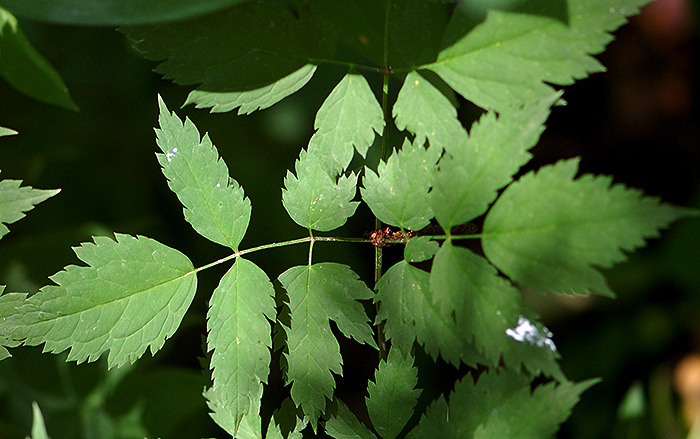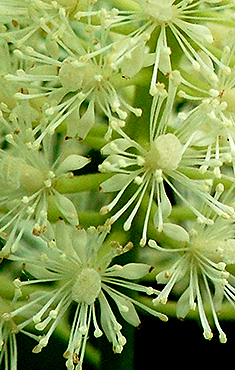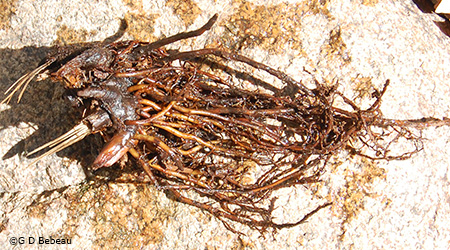The Friends of the Wildflower Garden, Inc.
Plants of the Eloise Butler Wildflower Garden
The oldest public wildflower garden in the United States

Common Name
White Baneberry (Doll's Eyes)
Scientific Name
Actaea pachypoda Elliot
Plant Family
Buttercup (Ranunculaceae)
Garden Location
Woodland
Prime Season
Spring Flowering
Baneberries are erect perennial woodland plants, 1 to 2 1/2 feet high.
The leaves of A pachypoda are divided 2 to 3 times into separate unevenly but sharply toothed, oblong 3-part leaflets which are usually hairless on the underside. This shape is similar to the Red Baneberry, A. rubra, except that A. rubra may have hair on the underside and the leaflets of A. pachypoda are generally more cut with more pointed teeth and lobes.
The inflorescence is a terminal cluster on a long stalk, cylindric in shape, and usually longer than wide, rising directly from the leaf stem, at or just below the division point of the 3 leaf parts, and then rising higher than the leaves.
Flowers are bisexual. The small cream colored flower petals number 4 to 10, are truncated at the tip or sometimes cleft and with a very tapered base. These fall off early leaving the stamens which can number 15 to 50, which have white long filaments and cream anthers. There is one pistil with the style either very short or absent. The sepals of calyx are whitish-green in color, and are not persistent on the fruit.
Fruit: The mature fruit is a white berry which is distinguished from the white-berry form of the Red Baneberry by the individual berries having a pink to red very thick stalk. Both however, have the dark spot at the end of the berry, the remains of the stigma, from whence comes the alternate common name of "doll's eyes." however the spot is larger in A. pachypoda and darker. The fleshy berries are oval in shape and contain 8 or more hard seeds that are cone shaped to wedge shaped, dark brown to reddish brown in color, 3.4 to 4.5 mm in size.
HAZARD: The word “bane” in the name tells you that Baneberry plants are poisonous and the berries are considered especially poisonous. More notes at page bottom.
Habitat: As it is a woodland plant White Baneberry is found in shady spots of open woods and forests where there is moderate moisture (mesic conditions). The root is a woody caudex with fibrous roots. Plants are very difficult to start from seed as there must be a cold moist storage period followed by a warm moist period, followed by another cold moist period, each period being at least 60 to 90 days. Planted outside, they would germinate in the 2nd year.
Names: The genus name Actaea is the Latin name that was used by Pliny and adopted by Linnaeus. The Latin is thought to come from old Greek, either aktea or akte, for 'elder' which probably refers to a similarity of leaf type with that plant. The species pachypoda refers to "a thick foot" referring to the thick berry stalks.
The author name for the plant description - 'Elliot’ refers to Stephen Elliot (1771-1830) American botanist and collector whose herbarium was the largest in America at the time. He is noted for A Sketch of the Botany of South Carolina and Georgia from 1821 in which was the description of this species. A scientific name that has been used by some for plant in years past is A. alba, but that name is believed to refer to a European species and should not be used here. (Ref. #W7, Vol 3)
Comparisons: A. pachypoda is similar to the white berry variety of Red Baneberry (Actaea rubra) except there the stalks of the berries are thin and green or brown, the petal tips are acute to obtuse; the flower cluster is usually no longer than wide but cluster shape is not absolutely definitive.

Above: 1st & photos - The elongated long-stalked flower cluster of the White Baneberry. 2nd photo - The underside of the leaf is hairless; the leaf edges more deeply cut than the Red Baneberry.
Below: The leaves are divided 2 to 3 times into separate unevenly but sharply toothed, oblong 3-part leaflets. Shown here are the 2 lateral sections with the partially shown terminal section extending upwards.

Below: Flower detail. The petals drop away early leaving the numerous stamens with their white filaments and a pistil which usually lacks a style.

Below: 1st photo - Developing berries of early July. 2nd photo - Fully mature berries of mid-September. Note the thick berry stalks of the true White Baneberry and their deep red color at maturity.
Below: 1st photo - The root is fibrous with wood a caudex. 2nd photo - The wedge shaped baneberry seeds, typical in number obtained from one berry.


Notes: Both Red and White Baneberry are indigenous to the Garden area. Eloise Butler catalogued the red on May 25, 1907 and the white on Oct. 9, 1909; in addition on July 11, 1912 she planted some plants of A. pachypoda that she obtained in Foley, MN and on Aug. 23, 1914 from Pine Coulee in St. Paul. In 1920 she got 3 plants from Gillett's Nursery in Southwick MA under the mis-assigned name of Actaea alba. Both species were listed on Martha Crone's 1951 inventory of plants in the Garden at that time. She also planted seeds in 1951 and '53. Gardener Cary George planted A. pachypoda in 1994. Both are native to Minnesota but with much different distribution. Red Baneberry, A. rubra occurs in most counties throughout the state except a few in the SW quadrant. A. pachypoda is restricted to just 11 counties, all on the east edge of the state, but running from the Arrowhead down to the SE Corner. In Canada it is found from Ontario eastward. These are the only two species of Actaea found in North America.
Medicinal Lore: Tilford (Ref. #39) reports that clinical herbalists have found the plant useful as a strong antispasmodic. The root is considered a strong alternative to Black Cohosh as a herbal remedy for menstrual cramping and menopausal discomforts. Densmore (Ref. #5), in her study of the Minnesota Chippewa reports the same use but refers to the roots of those plants of the species which bear the white berries. The plants that bear red berries are said to be used for diseases of men. Care had to be taken in any case, as large quantities of baneberry consumed may cause cardiac arrest.
Return to -- Site Plan/Archive Index --or-- List of Common Plant Names -- or -- List of Scientific Names -- or --Home Page - - - Back to top.
References: Plant characteristics are generally from sources 1A, 32, W2, W3, W7 & W8 plus others as specifically applied. Distribution principally from W1, W2 and 28C. Planting history generally from 1, 4 & 4a. Other sources by specific reference. See Reference List for details.
 Identification booklet for most of the flowering forbs and small flowering shrubs of the Eloise Butler Wildflower Garden. Details Here.
Identification booklet for most of the flowering forbs and small flowering shrubs of the Eloise Butler Wildflower Garden. Details Here.
©2013
Friends of the Wildflower Garden, Inc. Text and photos are by G. D. Bebeau unless otherwise credited. "www.friendsofeloisebutler.org"
062621